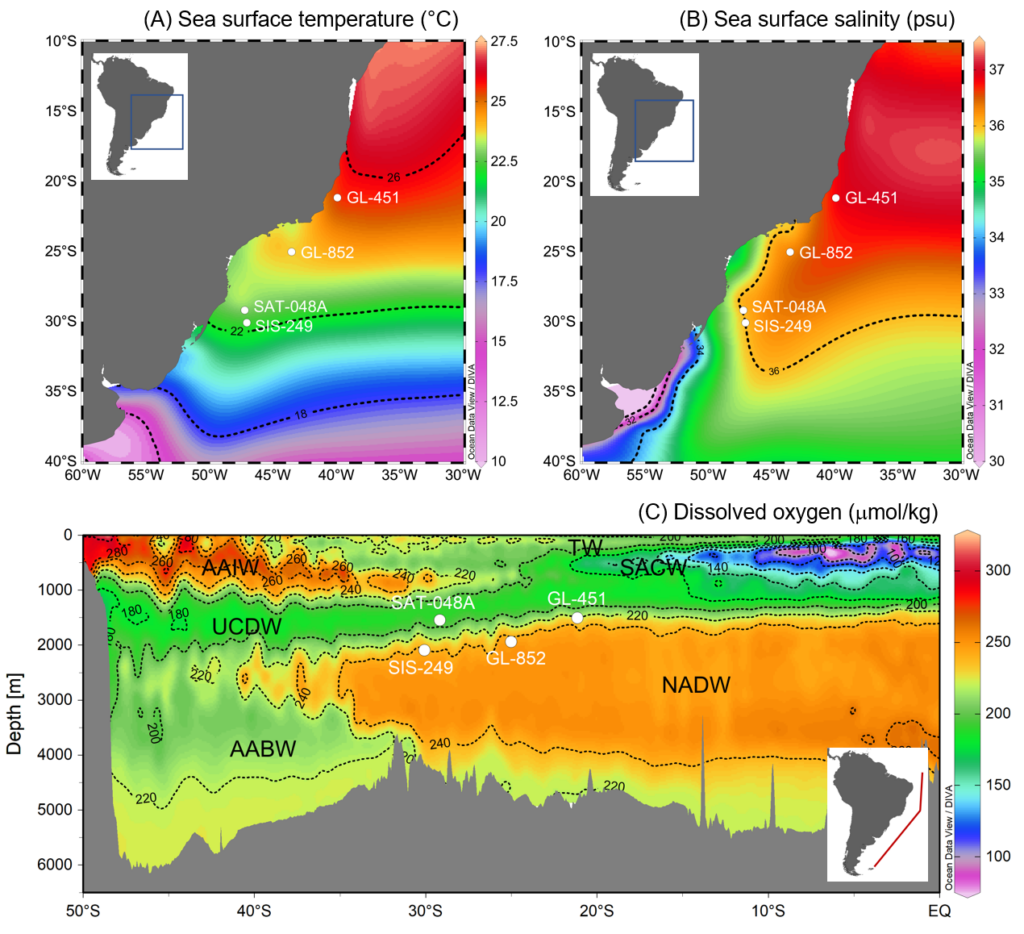Estudo de caso sobre produtividade, ventilação oceânica e dissolução de carbonato na margem continental sul e sudeste brasileira – insights para o armazenamento de carbono marinho.
A case study on productivity, ocean ventilation and carbonate dissolution from the S-SE Brazilian Margin – insights for marine carbon storage.
Funded by: FAPESP 2022/03830-3
Collaboration with Prof. Karen B. Costa, University of São Paulo
Filip Scheiner as a partner investigator
The aim of the project is to carry out an in-depth study of selected palaeoceanographic sites in the South Atlantic Ocean along the south-eastern Brazilian continental margin. The aim is to gain insight into the processes that influence carbon storage in the oceans. The selected sites provide a unique natural laboratory with specific parameters to test the main hypothesis that the geometry of the bottom water masses, together with enhanced productivity and organic matter flux, can act synergistically and have a significant impact on carbon storage in the oceans. Advanced geochemical techniques such as 143Nd/144Nd, Cd/Ca, Zn/Ca and δ11B will be combined with statistically based micropaleontological indices to provide robust datasets for palaeoceanographic interpretation. The project aims to confirm or reject the hypothesis of synergistic effects and to explain the role of the individual processes studied in this phenomenon.

Seagrass/seaweed meadows – overlooked Phanerozoic ecosystems: their contribution to shelf biodiversity and identification in the fossil record
Funded by: Czech Science Foundation 23-05217S
Collaboration with Dr. Martina Havelcová, Institute of Rock Structure and Mechanics, CAS
Principal investigator: Katarína Hocová
Seagrass/seaweed meadows represent over-looked diversity hotspots. They are key contributors to the production and accumulation of organic matter, and thus a significant factor controlling biodiversity and sedimentation in the shelf areas. In the fossil record their role and significance has not yet been fully understood. Since seagrasses/seaweeds are not well predisposed for fossilization, the primary aim of this project is to use a set of indirect markers/proxies (combination of paleontology and organic geochemistry) to be able to identify them in the fossil record. Further, this project will analyse fossil seagrass/seaweed ecosystems from several case studies from the Phanerozoic to evaluate the contribution to the overall shelf biodiversity, and to summarize pilot data regarding the biodiversity increase since the early Phanerozoic. The expected biodiversity increase is based on the assumption that the seaweed /seagrass meadows represented ecosystems characterized by unique gradual coevolution of autotrophic seagrasses/seaweeds with specific groups of heterotrophic organisms.

The Langhian Mediterranean-Paratethys enigma: hydrography based on Nd isotopes proxy on foraminifera revealing changes in paleoceanography
Funded by: Czech Science Foundation 20-05872S
Collaboration with Dr Lukáš Ackerman, Institute of Geology, CAS
Principal investigator: Katarína Hocová
The main goal of the proposed project is to provide a global model of oceanographic interactions within the Mediterranean-Paratethys marine system during the interval characterized by the closure of the Indic-Mediterranean gateway that is related with crucial Neogene climatic changes – the Monterey event. The proposed synthesis of multiproxy data should bring new insights into the evolution of one of the key areas representing a junction between two oceans. We are planning to use an innovative combination of progressive geochemical methods on foraminifera (high-precision, single-test 143Nd/144Nd analyses), together with the established ones (Mg/Ca; δ18O; δ13C). These geochemical methods will be used jointly with classical paleoecological and sedimentological approaches to obtain robust datasets for paleoceanographic interpretations. The project should elucidate the origin and evolution of the Mediterranean-Paratethys hydrography in relation to adjacent oceans (Atlantic, Indic) as well as assess the influences of the global climatic changes and the role of local source variations.
